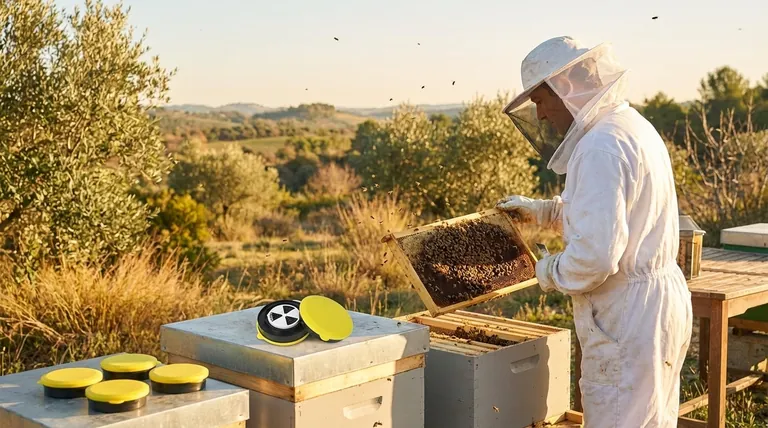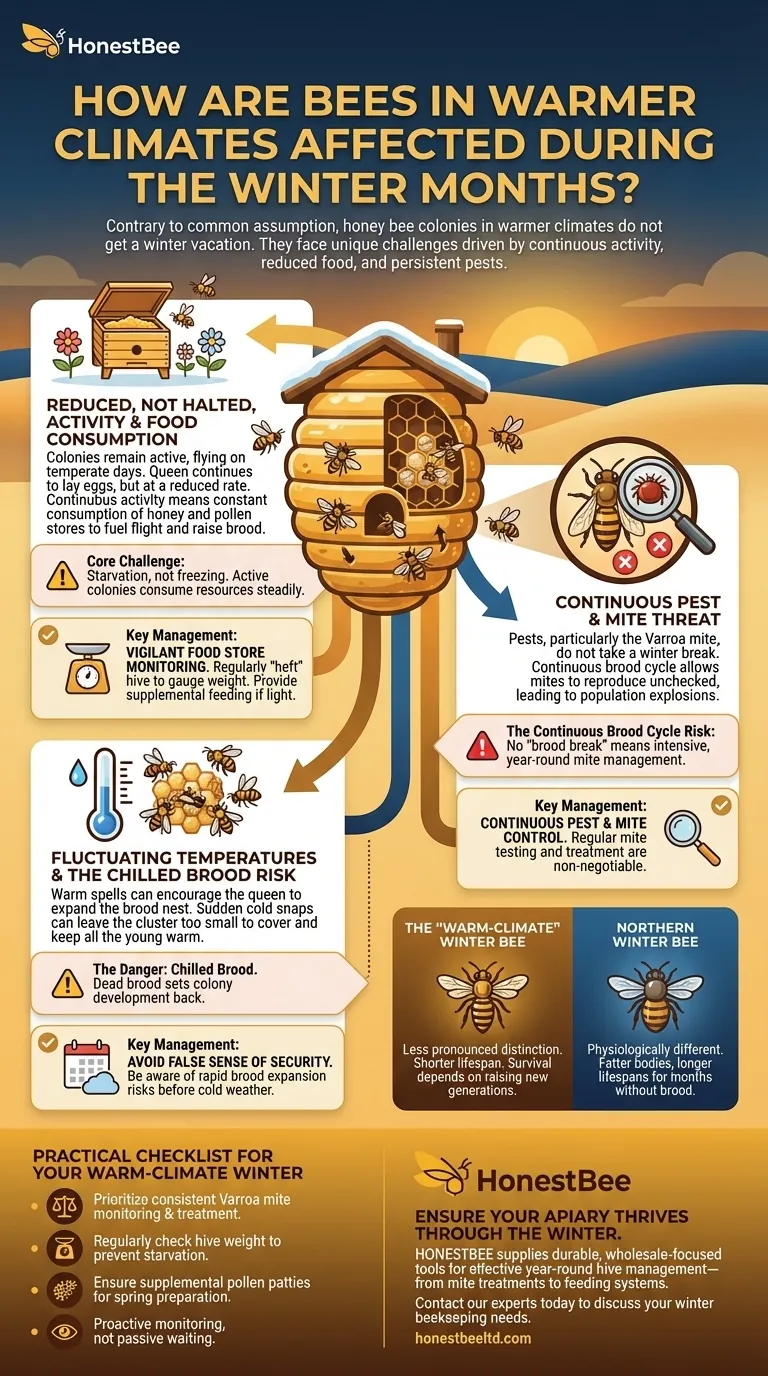Contrary to common assumption, honey bee colonies in warmer climates do not get a winter vacation. While they do not enter a deep hibernation-like state as their northern counterparts do, they face a unique set of challenges driven by reduced food availability, fluctuating temperatures, and the persistent threat of pests. Their winter experience is not one of survival against extreme cold, but one of resource management for a colony that remains active year-round.
The core challenge for bees in a mild winter is not freezing, but starvation. Because the colony remains active and continues to raise brood, it consumes resources at a steady rate even when flowers and nectar are scarce, requiring careful management from the beekeeper.

The Reality of a "Mild Winter" Beehive
Beekeepers in regions like the southern United States must understand that their winter management goals are fundamentally different from those in colder areas. The focus shifts from insulation and clustering to resource and pest management.
Reduced, Not Halted, Activity
In a warm climate, it is common to see bees flying on any temperate day, even in December or January. The queen often continues to lay eggs, though at a much-reduced rate compared to the spring and summer.
This continuous activity means the colony is constantly consuming its honey and pollen stores. Unlike a cold-climate colony that forms a tight, energy-conserving cluster, these bees burn through their food reserves to fuel flight and raise new bees.
The "Warm-Climate" Winter Bee
Colonies in frigid climates produce special "winter bees" that are physiologically different, with fatter bodies and longer lifespans to help the colony survive months without laying new brood.
In warmer regions, this distinction is less pronounced. The bees produced may have slightly longer lifespans to help the colony through periods of lower nectar flow, but they are not the super-survivors seen in the north. The colony's survival depends on its ability to keep raising new generations of workers.
Key Winter Management Tasks for Warm Climates
Because the hive remains active, the beekeeper's job does not stop. Winter management is about proactive monitoring to prevent predictable problems.
Vigilant Food Store Monitoring
This is the single most critical task. A colony can starve in a matter of weeks if its stores run out and there is no natural nectar flow. Beekeepers should regularly "heft" the hive by lifting it from the back to gauge its weight. A light hive is a sign of dangerously low food stores.
Continuous Pest and Mite Control
Pests, particularly the Varroa mite, do not take a winter break in warm climates. A continuous brood cycle means Varroa mites have a constant environment to reproduce.
Mite populations can explode over the winter in an unchecked hive, leading to a weak or dead colony by spring. Regular mite testing and treatment, in accordance with local conditions and regulations, is non-negotiable.
Understanding the Risks and Trade-offs
A mild winter presents its own unique dangers. A false sense of security is perhaps the greatest risk of all.
The Continuous Brood Cycle Risk
The primary trade-off of a mild winter is the lack of a "brood break." Without a period where the queen stops laying, Varroa mites can multiply unchecked. This makes mite management a more intensive, year-round effort compared to cold climates where the winter brood break naturally disrupts the mite's life cycle.
The Danger of Sudden Cold Snaps
Warm spells can encourage the queen to expand the brood nest. If a sudden, sharp cold snap follows, the cluster of bees may not be large enough to cover and keep all the young warm. This results in chilled brood, which dies and must be removed by the workers, setting the colony's development back.
A False Sense of Security
Beekeepers can become complacent, assuming warm weather means the bees are fine. This neglect is a primary cause of winter colony loss in southern regions, where hives are lost to starvation or mite infestations that could have been easily prevented.
A Practical Checklist for Your Warm-Climate Winter
Your winter strategy must be tailored to the specific challenges of a continuously active colony. Use these points to guide your management decisions.
- If your primary focus is colony survival: Prioritize consistent Varroa mite monitoring and treatment, and regularly check hive weight to prevent starvation before it becomes critical.
- If your primary focus is preparing for a strong spring: Ensure the colony has supplemental pollen patties if natural sources are scarce, which fuels brood-rearing for a powerful spring workforce.
Effective winter beekeeping in a warm climate is a game of proactive monitoring, not passive waiting.
Summary Table:
| Challenge | Impact on Bees | Key Management Action |
|---|---|---|
| Reduced Food Availability | Risk of starvation from active brood-rearing | Monitor hive weight; provide supplemental feeding |
| Continuous Varroa Mite Threat | Mite populations can explode without a brood break | Implement regular mite testing and treatment |
| Fluctuating Temperatures | Risk of chilled brood from sudden cold snaps | Avoid encouraging rapid brood expansion before cold weather |
Ensure your apiary thrives through the winter. The challenges of managing active colonies in warm climates require the right equipment and supplies. HONESTBEE supplies commercial apiaries and beekeeping equipment distributors with the durable, wholesale-focused tools needed for effective year-round hive management—from mite treatments to feeding systems. Contact our experts today to discuss your winter beekeeping needs and build a stronger, more resilient operation.
Visual Guide

Related Products
- Adjustable Formic and Acetic Acid Dispenser for Bee Mite Treatment
- 12V Bee Mite Removal Evaporator Oxalic Acid Vaporizer for Bee Fumigation Treatment 180W Atomization
- Professional Bamboo Queen Isolation Cage
- Professional Galvanized Hive Strap with Secure Locking Buckle for Beekeeping
- Black Plastic Beetle Barn Hive Beetle Trap for Beehives
People Also Ask
- How can beekeepers ensure their hives survive the winter? A Guide to Colony Survival
- What are some common predators and pests that target beehives? Protect Your Hives from Bears, Mites, and Beetles
- What should beekeepers do to manage varroa mites effectively? Adopt a Proactive Monitoring Strategy
- What does Chewed Down Brood (CDB) indicate in bee colonies? A Sign of Varroa Mite Infestation
- What is the focus of hive management during summer? Maximize Your Honey Harvest with Expert Tips



















